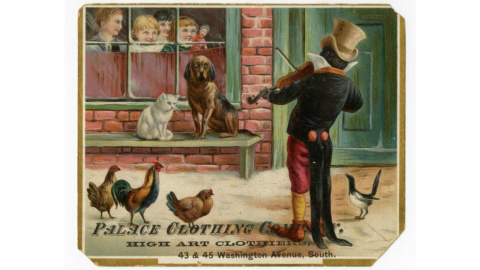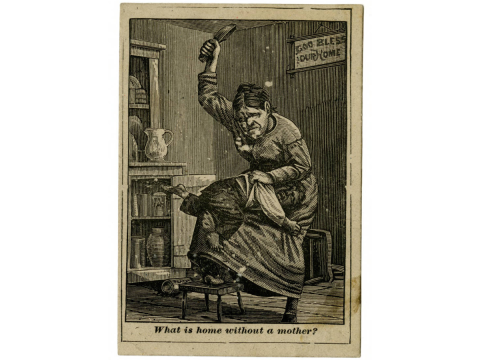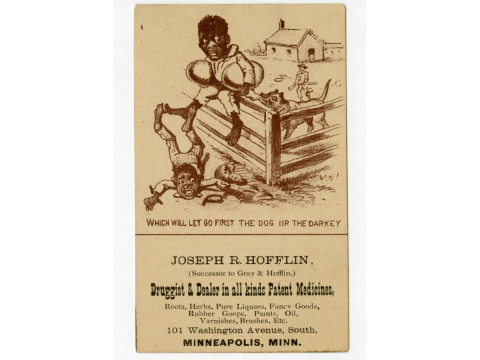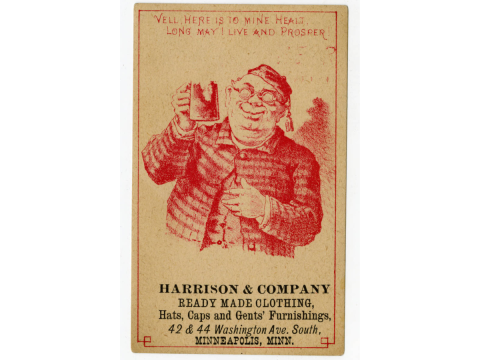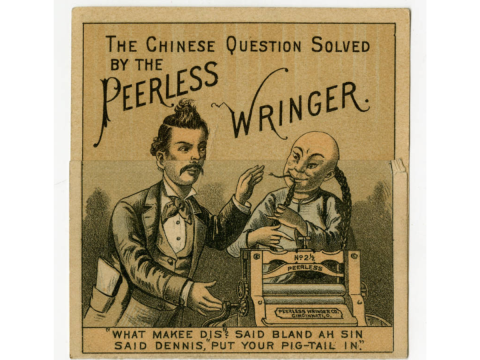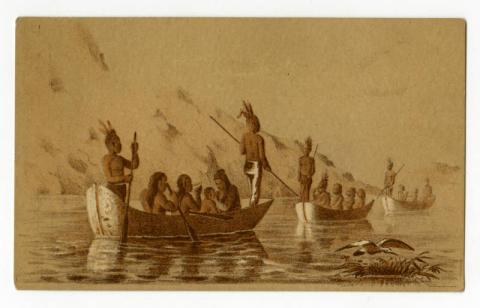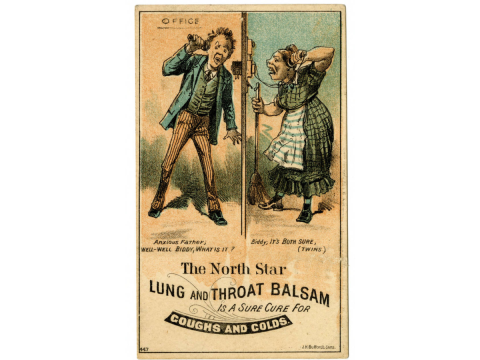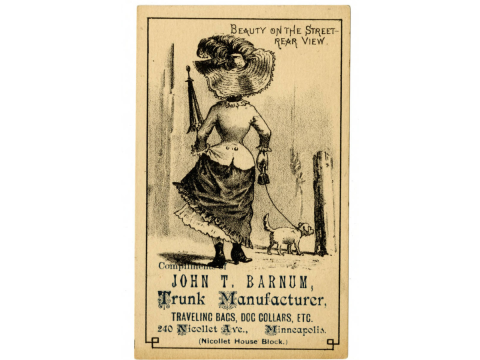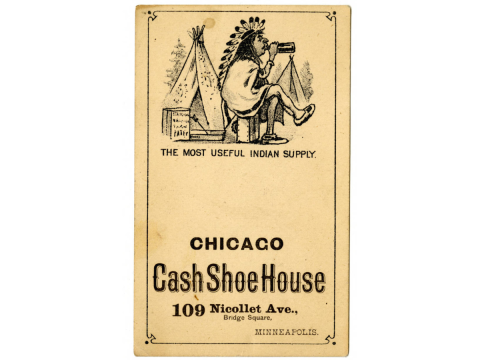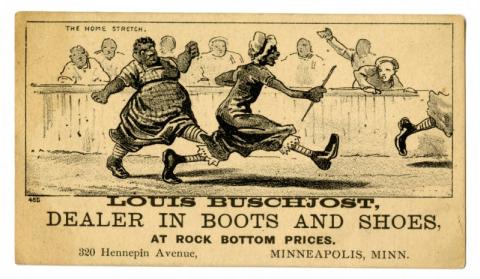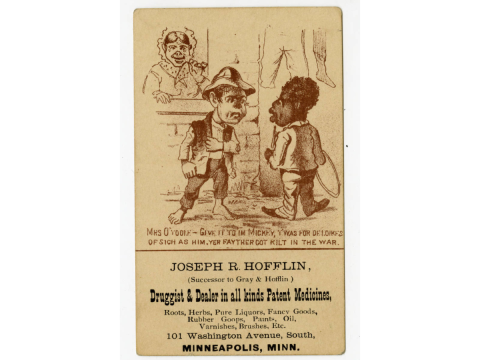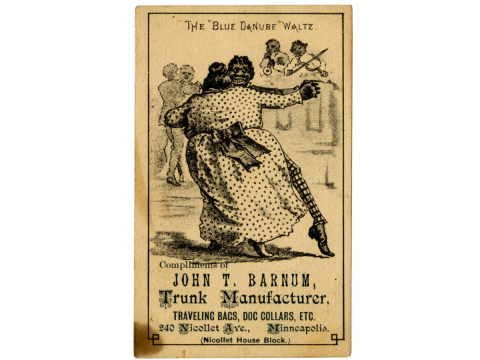Primary Source Set
by Jennifer Hootman, Digital Arts, Sciences, & Humanities (DASH) Program Associate, University of Minnesota Libraries - Twin Cities
Note: These trade cards contain offensive imagery and language. Discretion and discussion are advised for classroom use.
The second half of 19th-century America witnessed a boom in industrialization and urbanization. It was also a time when America experienced two more waves of mass immigration giving rise to greater diversity in population. Along with a tremendous increase in the variety of mass-produced goods, consumption, too, was on the rise. Consumers, then, became the targets of a new, cheaply-produced advertising medium, trade cards. These cards were small, usually ranging in size from approximately 2x4 to 3x5 inches. Often they included an image and promotional text which may have also included the business name and address. Widely-circulated and immensely-popular trade cards were freely given to any potential consumer or with a purchase. In fact, trade cards became so popular that some were collected and kept in scrapbooks.
The images included on the trade cards reflected the cultural roles and values of American life. In many cases these featured images of rural landscapes, floral arrangements, gleeful children, and pets. However, there were an equal number of trade cards that were derogatory, caricatured depictions of race, ethnicity, national identity, class, and gender, highlighting the anxiety and bigotry within white, Anglo-American society. And in these cases particularly, the popular trade cards not only reflected but also perpetuated insidious stereotypes. Even though these trade cards were exaggerated depictions, they also exhibited a sense of truth to the kind of treatment that these targeted groups endured. This primary source set is intended to provide context around these once-popular trade cards, to situate them historically, and inspire critical inquiry.
Source: Schröder, Nicole. "Commodifying Difference: Depictions Of The ‘Other’ In Nineteenth-Century American Trade Cards. Nineteenth-Century Contexts 34.2 (2012): 85-115. Academic Search Premier. Web. 14 Apr. 2016.
Discussion Questions & Activities
When you look at the trade cards in MDL, be sure to check if there is a back side too. Some have only one side, others have front and back sides, and one of them unfolds. Use the zoom-in tool to view subtle details in the images.
1. What product(s) were being advertised on these trade cards?
2. Who were the intended consumers?
3. Who was depicted on these trade cards?
4. Why did businesses use these stereotypes for advertising or to boost sales?
5. What similarities or differences do you see between the various racial, class, and gender depictions in this set of trade cards?
6. Look closely at the details of the images to uncover more subtle information about racial characteristics and discuss why these were used and what they say about American culture during this time. How was the concept of "the other" being used? What were the coded messages about race and gender?
7. How is race, class, and gender constructed differently between the card, “Theft of a Watermelon,” and the card, “Two Young Girls Fishing?” How do the images and language treat the children represented in the cards differently?
8. Cards “The Most Useful Indian Supply” and “Minneapolis Harvester Works” both depict Native Americans. What two opposing racial stereotypes do these cards draw upon?
9. How is class and gender constructed in the cards “What is home without a mother?” and “The North Star Lung and Throat Balsam.”
10. What racial stereotypes do the cards “The "Blue Danube" Waltz” and “Palace Clothing Company” share? How are they alike and how are they different?
11. The two cards “Beauty on the Street” and “The "Blue Danube" Waltz” were used by the same company advertising the same product. How are these two advertisements alike and different? What is the difference between the racial and gender depictions in each card?
12. Compare and contrast the depiction of women in “Beauty on the Street,” “The North Star Lung and Throat Balsam,” “What is home without a mother?,” and “The Home Stretch.”
13. Both cards, “Vell, Here is to Mine Healt, Long May I Live and Prosper” and “The Chinese Question Solved By the Peerless Wringer” point to large immigrant populations during second half of the 19th century. In what ways do these two cards differ in their racial discrimination and in what ways are they similar? To what historical social issue(s) and legislation during that time are these cards are referring? What is the symbolic significance of the product being sold in "The Chinese Question Solved by Peerless Wringer?"
14. Given that these trade cards were used by businesses in Minneapolis, what does that tell us about racism in America and in Minnesota during the second half of the 19th and early 20th centuries?
15. How do you see race, ethnicity, nationality, class, or gender being used in advertising and marketing today? Can you think of negative as well as more positive, empowering examples?
16. Working in pairs or small groups, have students search for additional trade cards on the MDL site that depict racial, ethnic, national, gender, or class stereotypes.
- When each pair or small group has chosen a trade card, ask them to create a list of reasons why they think it exhibits these stereotypes.
- Then have the pairs or groups search through a set of print magazines or online advertisements for one current example which exhibits racial, ethnic, national, gender, or class stereotypes and one current example which exhibits positive and empowering depictions.
- When each pair or small group has chosen two current advertisements, ask them to create a list of reasons why they think one exhibits stereotypes and why the other one exhibits a more positive depiction.
- Each pair or small group should then report back to the class to compare and contrast their chosen trade card and current advertisements and share their thoughts on what makes the advertisements racist, biased, or stereotypic and what effects they think it has on consumers. And, conversely, each pair or small group should share what they think makes an advertisement positive and empowering.
- Follow up with a classroom discussion on how current advertisements can be more inclusive and made without bias or stereotype. Finally, ask students to articulate ways in which the consumer can advocate for change in advertising and marketing.
17. Working in pairs or small groups, have students select two trade cards. Once they choose their two trade cards, ask them to critique the images for fictional, derogatory messages. Then, ask them to link the fictional, derogatory messages in the image to historical facts in how that group of people was treated.
eLibrary Minnesota Resources (for Minnesota residents)
1. Black, Jennifer M. "Corporate Calling Cards: Advertising Trade Cards And Logos In The United States, 1876–1890."Journal Of American Culture 32.4 (2009): 291-306. Academic Search Premier. Web. 1 Feb. 2016.
2. Kalba, Laura Anne. "How Media Were Made: Chromolithography In Belle Époque France." History & Technology 27.4 (2011): 441-453. Academic Search Premier. Web. 1 Feb. 2016.
3. Stiff, Paul. "Designing Information For Everyday Life." Design Issues 30.3 (2014): 78-83. Academic Search Premier. Web. 1 Feb. 2016.
Additional Resources for Research
1. Ashby, Samantha, et al. Race in the United States, 1880-1940, Bowling Green State University Libraries, 2013. Web. 1 Feb. 2016.
2. Holt, Thomas C, and Laurie B. Green. The New Encyclopedia of Southern Culture: Vol. 24. Chapel Hill: University of North Carolina Press, 2013. Print.
3. Jay, Robert. The Trade Card in Nineteenth-Century America. Columbia: University of Missouri Press, 1987. Print.
4. Norris, James D. Advertising and the Transformation of American Society, 1865-1920. New York: Greenwood Press, 1990. Print.
Published onLast Updated on
